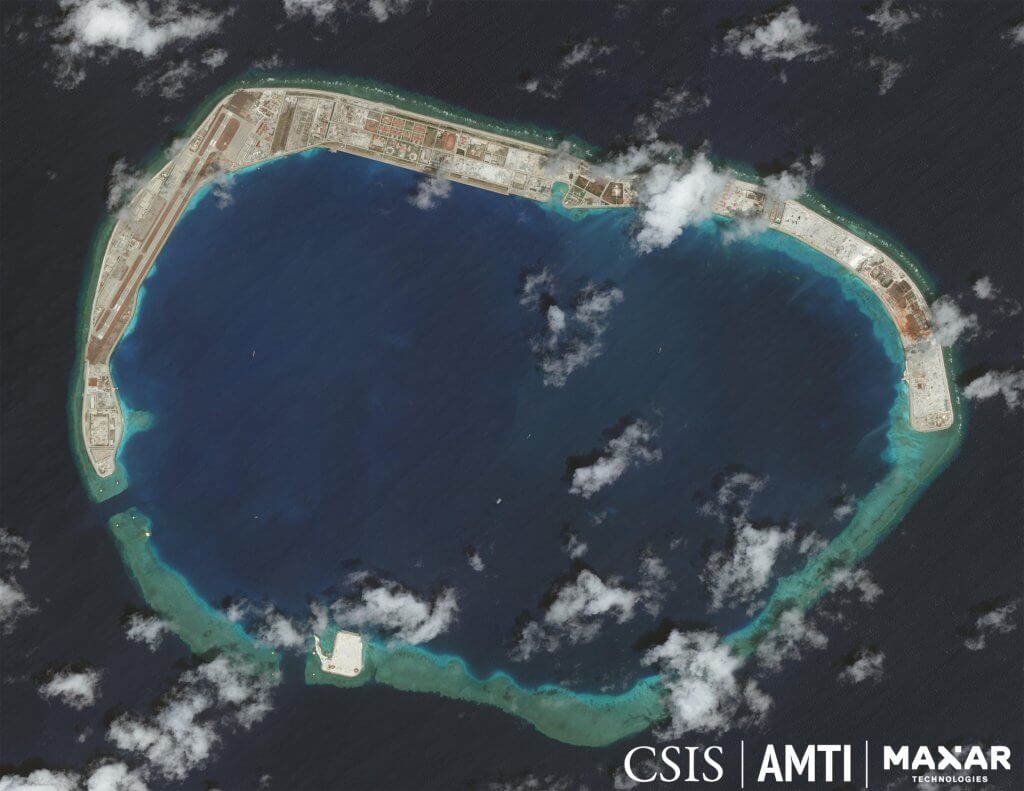
Introduction
The South China Sea, one of the world’s most strategically important waterways, has become the epicenter of a remarkable military transformation. Recent satellite imagery reveals the stunning scale of China’s military build-up across disputed islands and reefs, fundamentally altering the regional balance of power in ways that would have been unimaginable just two decades ago.
The Scale of Transformation
New satellite images from the Asia Maritime Transparency Initiative (AMTI) paint a picture of unprecedented military expansion. China now operates a sprawling 3,200-hectare network of military bases across the South China Sea, transforming once-submerged reefs into fortress-like installations capable of hosting advanced military aircraft, including nuclear-capable bombers.
The transformation of Mischief Reef exemplifies this dramatic change. Satellite comparisons show that what was merely underwater reef in 2004 has become a massive military complex featuring:
- Sprawling runways capable of handling large military aircraft
- More than 72 fighter jet hangars across major island bases
- Surface-to-air missile installations
- Anti-ship cruise missile emplacements
- Extensive radar and communications infrastructure
- Large harbors for naval vessels
As Gregory Poling, director of AMTI, describes it, these bases represent “the result of the quickest example of mass dredging and landfill in human history.”
Strategic Military Assets
China’s military presence in the region has grown to encompass 27 outposts total: 20 in the Paracel Islands and 7 in the Spratly Islands. Of these, four have been transformed into fully operational naval and air bases. The sophistication of these installations became particularly evident in May 2025, when satellite imagery captured two Chinese H-6K bombers—aircraft capable of carrying nuclear weapons—stationed on Woody Island in the Paracels.
This deployment marked the first confirmed presence of China’s most advanced bombers in the region since 2020, signaling Beijing’s growing confidence in projecting power far from its mainland bases. The H-6 bombers represent a significant strategic capability, with the range to threaten U.S. military installations throughout the region and the versatility to support various military scenarios.
Regional Tensions and International Law
China’s expansion occurs against a backdrop of competing territorial claims. Beijing asserts sovereignty over nearly the entire South China Sea through its “nine-dash line” claim, which overlaps with territories claimed by Brunei, Indonesia, Malaysia, the Philippines, Taiwan, and Vietnam. Crucially, a 2016 international arbitral tribunal ruled that China’s sweeping claims have no basis under international law—a decision Beijing categorically rejected.
The militarization of these features directly contradicts China’s earlier assurances. Chinese officials had previously promised that the island-building activities would not result in militarization, making the current reality particularly concerning for regional stability.
Broader Strategic Implications
These developments represent more than territorial disputes—they signal a fundamental shift in regional power dynamics. The South China Sea carries approximately one-third of global maritime trade, making control over these waters economically as well as strategically significant. China’s ability to project military power throughout the region from these fortified positions gives Beijing substantial leverage in any future crisis or negotiation.
The speed and scale of this transformation have caught many observers off guard. What began as seemingly modest construction projects has evolved into a comprehensive military network that extends China’s defensive perimeter hundreds of miles from its mainland coast. This “fait accompli” strategy has proven remarkably effective, creating new realities on the ground—or rather, on the water—that are difficult for other nations to reverse without risking major conflict.
The Challenge Ahead
For the United States and its regional allies, China’s South China Sea expansion presents a complex strategic challenge. The installations are now permanent features of the maritime landscape, defended by increasingly sophisticated military capabilities. Any attempt to challenge China’s presence directly would likely trigger a major regional crisis.
Instead, the focus has shifted to maintaining freedom of navigation, supporting allied nations’ territorial claims through diplomatic means, and developing military capabilities that can operate effectively in this new environment. The recent deployment of advanced bombers to these bases suggests that China views its South China Sea positions not as defensive installations, but as platforms for power projection throughout the broader Indo-Pacific region.
Looking Forward
The militarization of the South China Sea represents one of the most significant geopolitical developments of the 21st century. In less than two decades, China has fundamentally altered the strategic map of one of the world’s most important waterways. The satellite images that document this transformation tell a story not just of engineering prowess, but of strategic ambition that will shape regional dynamics for generations to come.
As tensions continue to simmer and new military capabilities are deployed, the South China Sea remains a critical barometer of great power competition in the Indo-Pacific. The question is no longer whether China can build and maintain these installations, but how the international community will adapt to this new strategic reality.
The implications extend far beyond the immediate region, serving as a case study in how technological capability, strategic patience, and determined action can reshape international boundaries and power balances in the modern era. For observers of international relations, the South China Sea serves as a real-time laboratory for understanding how the global order is being challenged and potentially transformed in the 21st century.
Sources: Analysis based on satellite imagery from Asia Maritime Transparency Initiative (AMTI), reports from The Independent, Defense Mirror, and other verified news sources.
That’s why we launched Charting the Course: Voices That Matter—a 24-part educational series breaking down how we got here, what went wrong, and what must happen next. Our goal is simple: educate the public, connect the dots, and build the support needed to close the readiness gap before it’s too late.
Let’s move beyond slogans. Let’s build understanding, accountability, and strength—before the next crisis comes knocking.



